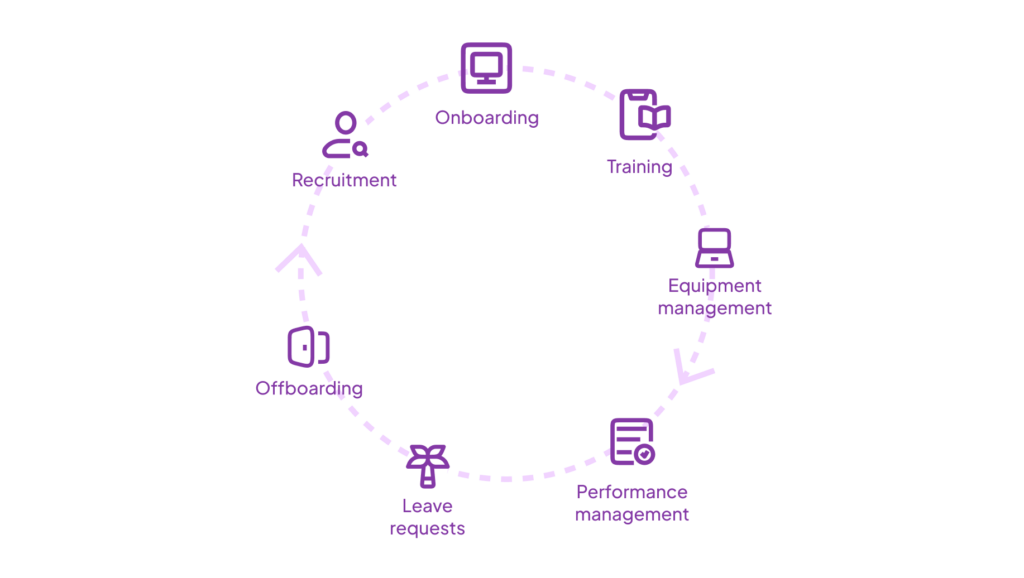If your business wants to stay competitive, well-organized HR processes aren’t just nice to have – they are essential for keeping your teams productive and your employees happy. When we talk about HR workflows, we’re looking at all those interconnected processes that keep your people operations running smoothly, from bringing new talent on board to managing performance reviews.
At Nintex, we’ve seen firsthand how the right workflows can transform an HR department. By automating repetitive tasks, your HR team can focus on what really matters – your people. Ready to dive in? Let’s explore what makes HR workflows tick, how to design them effectively, and where this technology is headed next.
The lifecycle of HR activities

Human resources workflow definition
A human resources workflow is a systematic approach to managing HR processes in a way that enhances efficiency and effectiveness. It covers the entire lifecycle of HR activities, from recruitment and onboarding to performance management and offboarding. Clearly defining each step in these processes ensures tasks are completed on time, reducing errors and delays.
Why choose HR workflow automation?
Optimizing HR workflow is crucial for improving processes. Streamlining HR functions eliminates redundancies and enhances collaboration among team members. This leads to a more agile HR department that can adapt to changing business needs and provide better support for employees. Additionally, a structured workflow promotes consistency in handling HR tasks, ensuring that policies and procedures are uniformly applied across the organization.
Implementing HR workflow automation offers numerous benefits. It saves time by automating repetitive tasks, allowing HR professionals to focus on strategic initiatives. Automation enhances accuracy by reducing human error, ensuring critical data is captured and processed correctly. It also improves employee experience by providing quicker responses and streamlined processes, leading to higher satisfaction and retention rates. By adopting HR workflow automation, organizations can thrive in a competitive landscape.
Key components of an HR workflow
Key components of an effective HR workflow include employee onboarding and offboarding, performance management, and leave and vacation request management.
Employee onboarding is the first step in creating a positive work experience, ensuring new hires feel welcomed and prepared. This process should provide essential training, resource access, and integration into company culture. Similarly, offboarding is important for maintaining relationships and ensuring a smooth transition when an employee departs, covering exit interviews, knowledge transfer, and final paperwork.
Performance management and evaluation are significant aspects of HR workflows. Regular performance reviews foster employee development and align individual goals with organizational objectives. A streamlined performance management system helps track progress and facilitates constructive feedback, creating a culture of continuous improvement.
Leave and vacation request management is equally important, as it helps maintain workforce productivity while respecting employees’ needs for time off. A well-structured leave management process simplifies request submissions, approvals, and tracking, ensuring both compliance and transparency.
By focusing on these key components, organizations can create a robust HR workflow that enhances employee satisfaction, increases operational efficiency, and drives success.
Implementing HR workflow automation
Implementing HR workflow automation can significantly improve the efficiency of HR processes. The first step is choosing the right workflow automation software that aligns with your organization’s specific needs. Look for solutions that offer user-friendly interfaces, scalability, and features tailored for HR functions.
Integration with existing HR systems is also crucial for a smooth transition to automation. Your chosen software should seamlessly connect with current applications, such as applicant tracking systems, payroll, and performance management tools. This not only simplifies data management but also ensures workflows are consistent across platforms. Nintex’s automation solutions integrate with a variety of existing systems, allowing for a cohesive approach to HR management.
Ensuring compliance and data security is paramount when automating HR workflows. With sensitive employee information at stake, it is essential to select software that adheres to industry regulations and employs robust security measures. Nintex prioritizes compliance and security, providing features that help organizations maintain data integrity and protect against potential breaches. By focusing on these key areas, you can implement HR workflow automation that improves productivity while safeguarding your organization’s data.
HR workflow automation checklist

Best practices for designing effective HR workflows
Designing effective HR workflows is crucial for enhancing productivity and ensuring a seamless employee experience. One of the first steps in this process is identifying bottlenecks that hinder efficiency. By analyzing current workflows, HR professionals can pinpoint areas where delays occur, such as lengthy approval processes or redundant tasks. Streamlining these processes saves time and improves overall satisfaction for both HR teams and employees.
Involving stakeholders in the workflow design is another best practice that can lead to more effective outcomes. Engaging employees from various departments ensures the workflows reflect the needs and expectations of all parties involved. This collaborative approach fosters a sense of ownership and accountability, making it easier to implement and adapt new workflows across the organization.
Continuous improvement and iterative optimization are vital components of effective HR workflows. It’s important that your HR team regularly reviews workflows to identify areas for enhancement. By gathering feedback from users and monitoring performance metrics, HR teams can make informed adjustments that contribute to ongoing efficiency and effectiveness. Leveraging tools like Nintex’s workflow automation solutions can simplify this process, providing the insights and capabilities needed to refine HR workflows continuously.
Before & after: The real impact of HR workflow automation
HR workflow automation eliminates inefficiencies—transforming manual, error-prone tasks into streamlined, consistent, and fully integrated processes.
| BEFORE | AFTER |
|---|---|
| Manual data entry errors | Automated data capture |
| Time-consuming repetitive processes | Streamlined workflows |
| Inconsistent policy application | Standardized processes |
| Delayed approvals | Automated approval processes |
| Lack of integration with existing systems | Seamless system integration |
Case study: A successful HR workflow implementation
University of Maryland Upper Chesapeake Health (UM UCH) needed to streamline operations to ensure continued high-quality patient care while continuing to grow the organization. However, their process for onboarding new employees and for closing accounts when an employee left the organization took “an inordinate amount of IT staff time and attention,” said Rick Casteel, Vice President of IT.
Plus, UHC employee productivity suffered from cumbersome manual processes that slowed operations and made it more challenging to comply with patient privacy and security regulations and accommodate growth.
When the organization adopted Nintex Advanced Workflow, which works with its existing SharePoint solution and gives UCH developers easy-to-use tools to automate time-consuming processes, it saw the investment pay off in several ways:
“We saw that by automating account creation, deletion and the steps in between, we could ensure that we handle the whole process in a consistent fashion, minimize the risk of human error and free up IT staff for more valuable tasks,” Casteel says.
Future trends in HR workflow automation
As organizations aim to improve their HR operations, the integration of AI and machine learning in HR workflow automation is set to further transform the industry. These technologies allow HR teams to analyze vast amounts of data to identify patterns and make informed decisions. This not only streamlines processes but also allows HR professionals to focus on strategic initiatives rather than routine tasks.
Another significant trend is the rise of employee self-service portals. These platforms let employees manage their own HR-related tasks, such as updating personal information, requesting time off, and accessing training resources, all without needing to involve HR personnel. This self-sufficiency enhances employee satisfaction and frees up HR teams to concentrate on more complex issues that require their expertise.
The increasing use of mobile applications is also facilitating HR workflow automation by providing employees with anytime, anywhere access to essential resources and processes. Mobile HR apps enable staff to handle tasks on-the-go, whether they are submitting expenses, checking leave balances, or accessing training modules. This flexibility improves employee engagement and ensures HR processes remain efficient and responsive to the needs of a modern workforce.
FAQ
What is an HR workflow? An HR workflow is a series of processes and tasks that streamline HR functions, from recruitment to onboarding and performance management.
Why is HR workflow automation important? HR workflow automation saves time, reduces errors, and improves employee experience by automating repetitive tasks and ensuring critical data is processed correctly.
How can I choose the right HR workflow automation software? Look for software that offers user-friendly interfaces, scalability, and robust features tailored for HR functions. Ensure it integrates seamlessly with your existing HR systems.
What are the key components of an effective HR workflow? Key components of an HR workflow include:
- Employee onboarding and offboarding
- Performance management
- Leave and vacation request management
Relevant Content Links
For more information on how Nintex can help with HR workflow automation, check out the following links on our website:
